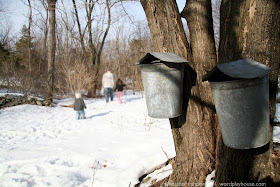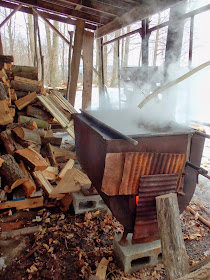Dateline: 25 March 2014
 |
| Family-scale syrup production. Photo Link |
 |
| Plastic sap lines |
 |
| An enormous maple syrup evaporator. Click Here to read an interesting article that goes with this picture. |
I like making maple syrup the old way because, for one thing, the older way is more reliable and sustainable. If the grid goes down, and/or the plastic factories can’t make their product, and/or gasoline and fuel oil becomes hard to get, I’ll still be making maple syrup just fine. I'll still have a good dose of sweet, condensed tree minerals in my morning cup of coffee. But, more than that, I’ll still have maple syrup that tastes good.
And now….. for some radical contrast between industrial maple syrup production and down-home, contra-industrial, agrarian-curmudgeon, backyard maple syrup production, here is a little photo chronicle of this years operation on our homestead:
What your'e looking at in the picture above is a dearth of firewood. That space was packed full at the beginning of winter. It has been an unusually cold winter and the woodshack is almost empty (some people have spiffy wood sheds. I have a wood-and-tarp wood shack). There is enough wood in that picture to get us to warm weather, but not to boil down a few gallons of maple syrup. So…..
That right there is my homestead work-car. Some homesteaders have trucks. I've got a work-car. The firewood was cut in my woods. I just drove down the road, cut some dead trees and loaded them in the trunk.
By the way, that's also the family default car. When one of my kids has a problem with their vehicle, they can drive my work-car. Since I no longer drive to a job in the city every day, the car is usually available. It barely passed inspection last year, and probably won't pass this year. But I've got a couple more months before I may have to finally buy a new vehicle. By "new" I mean new like my new maple syrup evaporator firebox…..
Ain't she a beauty? Well, that old firebox is truly an improvement over the 55-gallon drum we have used for years. It sets up higher and I was able to lay in firebricks on the sides. Now the metal on the outsides is only warm to the touch, not hot. If you click the picture you can see better where I cut out a section of the metal so my old boiling pan with its outlet drain would slide down into place.
In the picture above, you can see the "door" on the firebox. Those pieces of steel (held in place with a piece of firewood) came from the 55-gallon firebox I made a few years ago. You don't want to throw out rusty old pieces of steel like that when you have a scrappy little homestead because you never know when they can be employed to serve a necessary purpose. The hose you see (held in place by a length of baling wire) is what feeds sap into the pan. Here's a picture of the sap barrel….
It was an overcast and cold day when I took these pictures. But you can see enough to grasp the concept (click to see an enlarged view). The sap is collected from the trees with buckets. The buckets are dumped into the plastic barrel. Sap flows by gravity from there into the evaporator pan. The barrel is supported by a pallet platform. Pallets are another handy item on a homestead (you can never have too many pallets). The right side of the platform pallet is attached to my house. You can do things like that when your house is sided with just plywood and tar paper. I've got most of the house sided and painted but this side is different. It's kind of like my "work-car" side of the house—not all that great to look at, but very functional. Here's another view of the operation…
Once we have a full barrel of maple sap, we start boiling in the morning and boil into the evening. I hook up a light and it's kind of nice to hang out around the fire.
When my boys were younger, and the whole family made maple syrup together, we would all gather in the "sugar shack" at night and enjoy the ambiance of it. Maple steam, and smoke, with everyone all together makes for good memories.
Two of my sons (Chaz and Robert) have helped this year with tapping trees and collecting sap. The evening after I took the pictures above, the two of them were sitting on upturned buckets by the boiling pan of sap. I was glad to see it. Instead of some modern amusement, they were re-living a good experience from their childhood.
Marlene was away helping a family member with something. James was working at his job, but I was home. I went out and spent some time around the evaporator. Eventually I went to bed (I need my sleep!), but they stayed out there 'till midnight.
If we don't get the whole batch boiled down in a day, we just leave the pan overnight and fire it up again the next day. That's what we did with our first (and only) boil of this season. We ended up with 1.5 gallons in quart canning jars.
Now we're waiting for the weather to warm up again and the sap to start flowing again. A gallon and a half won't last us a year, and I don't want to have to buy syrup from the industrial providers.
 |
| Marlene tending the fire last year. This picture shows the old firebox, and a jar of the finished product. |






Loved this post. I spent all day watching the fire on our little maple syrup experiment and my husband came home from work telling about his idea to make an evaporator from two metal file cabinets. We just have two trees tapped with one tap each and have collected about 10 gallons which we spent yesterday and today boiling down. We're just using a wood-fired BBQ with a big enamel pot on it. We started very small this year to figure out the process and see if we even like the product. We are not fond of commercial maple syrup. But since my husband is already thinking of ways to tweek our process I guess we'll be going bigger next year and perhaps selling our wares. The highlight of my day... my son telling me I smelled like salmon. I guess that means I smelled like smoke.
ReplyDeleteHerrick, I enjoyed the info about making maple syrup - I've never done it. But what I liked best was how your boys helped you and hung out in the sugar shack with you. Thats awesome. Good post. Thanks
ReplyDelete"If the grid goes down, and/or the plastic factories can’t make their product, and/or gasoline and fuel oil becomes hard to get, I’ll still be making maple syrup just fine. I'll still have a good dose of sweet, condensed tree minerals in my morning cup of coffee."
ReplyDeleteDoes coffee grow up where you're at? ;)
I have a friend in Minn. who lives fairly primitively in a one room cabin in the woods hunting, fihing and gathering. He sends me some of his syrup every year, it is better than store bought!
Awesome post. I did not know that industrial operations actually pumped syrup out of the trees. Seems to me this would be overly stressful on the trees. I agree with the other poster - my favorite detail was how two of your sons showed up to help out.
ReplyDeleteCynthia—
ReplyDeleteA lot of people think about making their own maple syrup but they never do it. You've taken the first step and are actually doing it, on a small scale, without investing a lot of money, and that is commendable.
Todd—
Thanks for noticing the best part. We started making maple syrup years ago as a productive activity for the family to do together, as much as for making maple syrup. So it really is pleasing to see my sons helping again.
roger u—
Yes, we grow coffee up here. I wrote about it In This Blog Post. :-)
I do believe I could live like your friend and be perfectly content. Thanks for the comment.
Tim,
ReplyDeleteAs I understand it, the sap in the trees has a natural positive pressure to it and the vacuum in the hose is just enough to give a little bit of pull. It isn't a lot of suction, but enough to make a difference.
I love seeing the home-made setups other people use for these types of activities. You don't have to buy a Maple Boiler 2000 (TM) from the box store!
ReplyDeleteOut of interest, how do you store your collection of bits and pieces that might be useful one day? I've collected a lot of timber, pallets, chicken wire, metal pipes, etc, and have a hard time keeping it all out of the weather, clean, dry and out of the way. I'd love to see some storage ideas!